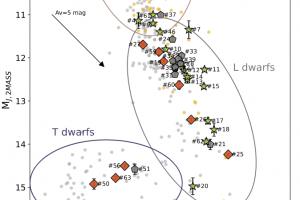Fifteen spectral indices to select planetary-mass objects. The study: “Spectral characterization of young LT dwarfs” of L. Piscarreta (CENTRA, ESO) appeared on A&A

Understanding the star formation process also means acquiring a full understanding of its final products, such as the mass distribution of the stars formed in a single star-formation event (which is the initial mass function). In particular, it is still not clear what the dominant mechanism responsible for the formation of the less massive sources is: the planetary-mass objects, with a mass ranging from 5 to 12 Jupiter masses. Two main mechanisms have been proposed so far. These objects could form like the more massive stars, through the gravitational contraction and fragmentation of molecular clouds. Alternatively, they may form in protoplanetary disks, which are disk-like structures orbiting around very young stars that host the planetary formation process. In this latter case, these objects would form like planets and then be ejected from their parental system due to gravitational interactions.
The study of planetary-mass objects is complicated by their intrinsic faintness. To date, only a few dozen such objects have been confirmed, typically in star-forming regions near the Sun. However, in the coming years, the number of known planetary-mass objects is expected to increase, mainly thanks to the James Webb Space Telescope. This is due to its unmatched capability of observing faint objects and its sensitivity to infrared emission, which is the type of radiation mainly emitted by such cold objects.
It is thus very important to define diagnostics that could allow astronomers to select planetary-mass objects, particularly the smallest ones of spectral classes L and T. This is the objective of the study led by the astronomer L. Piscarreta (Center for Astrophysics and Gravitation of the University of Lisbon and European Southern Observatory), based on the analysis of the spectra of 56 ultracool dwarfs with ages between 10 and 600 million years, acquired with the X-shooter spectrograph of the Very Large Telescope. The authors of this study have successfully identified 15 diagnostics based on the measurements of the flux in specific bands associated with molecules populating the atmosphere of this class of stars. Additionally, for the L-type objects, some of these indices also allow the separation of young from old objects, thus providing powerful selection criteria for evolutionary studies. The authors also provide a set of 12 objects to be used as near-infrared spectral standards for young LT dwarfs, helpful for the calibration of future observations of stars of this class. The research is described in the paper: “Spectral characterization of young LT dwarfs“, recently published in the journal Astronomy & Astrophysics. Among the authors of the study is the astronomer Victor Almendros Abad, of INAF – Astronomical Observatory of Palermo.
The cover figure (click here to view it in full) shows a color-magnitude diagram, specifically comparing the absolute magnitude in the J photometric band (corrected for the dimming of sources due to distance and the absorption of radiation by the interstellar medium, known as extinction) with the color J-Ks (the difference between the magnitudes in these two photometric bands) of objects at very low gravity (orange circles) and field stars (grey circles). The sample is divided into four age intervals: objects younger than 30 million years (green), between 30 and 100 million years (dark gray), between 100 and 300 million years (red), and between 300 and 600 million years (white). The ellipses delimit the regions occupied by sources of spectral type M (upper ellipse), L (central ellipse), and T (bottom ellipse). The arrow indicates the effects of an extinction that increases the magnitude by 5 (remember that in astronomy, magnitudes increase for fainter stars).
Mario Giuseppe Guarcello ( follow mariospiegacose) ( mariospiegacose) ( follow mariospiegacose)
Follow the Astronomical Observatory of Palermo on Facebok and on Instagram
Subscribe the Youtube channel of the Astronomical Observatory of Palermo
